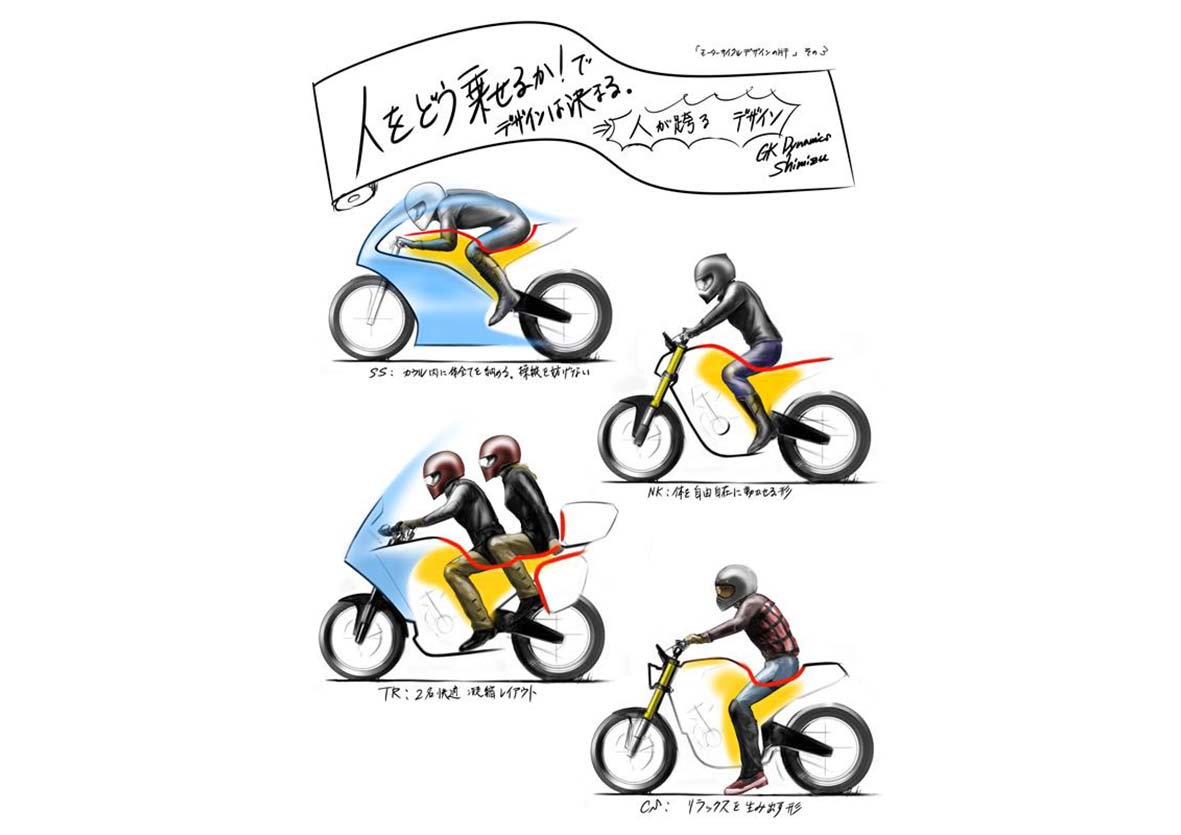Copyright GK Dynamics Inc., All Rights Reserved.

Copyright GK Dynamics Inc., All Rights Reserved.



Motorcycles provide a unique means of mobility that requires people to straddle on the vehicle to drive them.
When designing motorcycles, designers are often told to achieve a sense of unity between riders and machines or create forms completed with humans straddling on them. What’s more important, however, is how to fix riders’ straddling positions on the vehicles so they can get a new sense of controlling. Do you know this has become an element of creating new designs?
Take for example machines for racing. Each maker and each rider have their own theory for riding. Looking back on history, the riding position has shifted from the seat above the back wheel to the position of a higher center of gravity near the front wheel. Each time the riding position shifted, motorcycle design has changed accordingly, leading to a result that what turned out to achieve good performances was regarded as advancement. The design as I mention here includes not only formative design but also designs of layout and packaging.
This change significantly affects the design of motorcycles, especially their forms. Whether designers can intentionally put that into concrete forms determines the quality of their design output. That’s what I was often told by my senior colleagues at GK Design.
Let’s do some creative practice using an attached sketch.
When we successfully organize these elements into a concrete form, the motorcycle’s silhouette emerges as indicated in red lines and its surface and volume are fixed as shown in yellow paintings.
Forms of gas tanks of racing motorcycles are unexceptionally influenced by the form of human bodies. For riders to put their heads behind the cowls, they need to place the chins of their helmets as lower as possible. In some cases, they are also required to control their riding as if to grip the machine bodies with their arms while compactly maintaining the space inside their arms to avoid operational troubles. The tanks also need to be provided with forms that guarantee sufficient capacities for gasoline to avoid gas shortages during the race while ensuring that the riders’ belly parts do not touch the tanks’ surfaces. The seats need to have wide spaces for the riders to feel the spinning of rear wheels while shifting their bodies from side to side. The spaces inside the legs need to be designed by considering the moves of riders while at the same time, the legs must be held behind the cowl when the riders take a heads-down position.
Can you understand that almost all motorcycle designs are determined by humans’ physical elements?
By pursuing this way of thinking to the extreme, designers can understand the full extent of ergonomic design to produce appealing elements. That’s the reason why I think racing machines always appear attractive.
To avoid taking too much time to give further explanations, I want the readers to stretch their imagination through pictures. What I explained so far provides a point of view that’s more important than that of graphical design as the quality of motorcycle design depends much on factors like wind flows and riders’ moves.
GK makes the most of this viewpoint in making design for every genre of products. What’s most important is the process where designers exchange in-depth opinions with clients and make efforts to understand the aims of planners, engineers, and experimental riders to produce final design outputs.
I’d like to take another opportunity to explain product design in domains other than motorcycles.
Isn’t it interesting that motorcycle designers take an approach aimed at depicting riders on motorcycles in earnest?
Yoshiro Shimizu
Product Design Dept.
Operating Officer